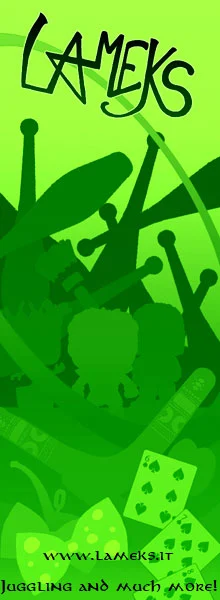madonna ma quanto hai scrittto!!
cmq questo è tratto da renegadejuggling.com
è fatta abbastanza bene... se poi qualcuno ha voglia di sbattersi e tradurla bene ben venga!!
LIQUID FUEL
KEROSENE (called paraffin in many places outside the U.S.) is the safest fuel for all fire props. That doesn't mean that it is safe, but it's safer than any other kind of liquid fuel. It is the least explosive of fuels. When torches are blown out, they can be lightly dipped in kerosene to stop all the residual smoldering which would otherwise eat up the wicks. Try this with any other liquid fuel or combination of fuels and any remaining embers in your torches will light the fuel jar or cause it to explode.
Pure kerosene is not particularly toxic. If splashed on the skin it should be wiped promptly, but if it isn't it will only give you contact dermatitis (skin rash). If it is splashed in the eyes it should be thoroughly rinsed out. If you should drink some, drink a glass or two of water to reduce the possibility of indigestion, gas, or diarrhea, but do not induce vomiting (because of the possibility of inhalation).
However, only a very few brands of kerosene are 100% pure, with no additives. These are sold as aviation fuel and are not available to the general public. As of December 1998, I can find only Exxon Aviation Turbo Fuel, Mobil Jet Fuel-Kerosene turbine fuel, and Pennzoil Kerosene Turbine Fuel (Aviation).
All of the several hundred other brands and types of kerosene (aviation fuel, coal oil, heating oil, lamp oil, and fuel oil) contain a variety of extremely toxic ingredients, principally benzene and naphtha. These are absorbed though the skin and mucous membrane, and accumulate in the liver and kidneys. Some directly attack the corneas, so if such kerosene is splashed into the eyes, the eyelids should be held open and flushed for fifteen minutes, and you should seek medical attention immediately. Again, if swallowed, do not induce vomiting, but do seek medical attention immediately.
What this means is that all kerosene should be treated as if it is highly toxic. If the Manufacturers Safety Data Sheet (MSDS) for a particular brand of aviation-type kerosene says that it is one of the few that are 100% pure kerosene, then you might trust it if you also see the barrel it comes out of and read the labels on that barrel. Treat anything that is repackaged for retail sales (smaller than 55 gallon drums) as highly toxic. I've heard reports of people repackaging various grades of kerosene as nontoxic or good for jugglers and fire-eaters--some were, some weren't.
Scented and unscented lamp oil is kerosene without the bad smell. But contrary to popular belief, the additives that make it smell nice also make it more poisonous. Roman Oil was originally a naturally occurring fuel and lamp oil without the usual odor or smokiness. Again the assumption was that if it didn't smell bad it wasn't bad for you. And again, the assumption was wrong: it is often among the more toxic of kerosenes.
COLEMAN FUEL and LIGHTER FLUID (Ronsonol and Zippo) consist of naphtha with various additives to control smell and appearance. They are preferred by many jugglers because they are not as smoky or as smelly as kerosene, and they light quickly. But naphtha is much more volatile than kerosene--that is, it is more likely to explode or get out of control than kerosene. Even approaching naphtha-based fuel while holding smoldering torches can cause it to explode if the weather is right. You must completely extinguish all smoldering and wait at least thirty seconds before recharging your torches when using naphtha. Naphtha is also highly toxic.
CHARCOAL STARTER (Kingsford and Wizard) is a mix of kerosene and naphtha. Some jugglers prefer a mixture of 4 parts Coleman to 1 part charcoal starter, because they think it makes a brighter but safer flame, with less smoke and stink. Others mix Coleman and kerosene to produce the same effect. All of these fuels are highly toxic if inhaled or ingested.
GASOLINE, PAINT THINNER, AIRPLANE FUEL, and other highly volatile fuels are extremely explosive and extremely toxic. The fumes remaining in a one-gallon can that has been emptied of gasoline can explode with the force of a stick of dynamite. When it is very hot and humid, gasoline fumes will not readily disperse and may be ignited as much as a half hour after all the original products are capped and stored. The fumes from Coleman, lighter fluid, and barbecue starter will explode almost as readily, but not with quite the same force--say, a half-stick of dynamite. Kerosene and lamp oil are fairly hard to blow up, which is why they are used in lamps and home heaters.
GRAIN ALCOHOL is produced by fermentation. It is the basic ingredient in beer, wine, and liquors, and is not immediately poisonous. Beverages with an alcohol content of 60% (120 proof) or higher are volatile enough to be used with fire props, but are seldom used because they produce a wimpy flame.
Fire-eaters and fire-breathers sometimes use high-proof liquor, such as Ron Rico Purple Label Rum. This avoids the problems of poisoning, but blowbacks are just as likely. EVERCLEAR, which is pure (100%, 200 proof) grain alcohol, is also sometimes used. It approaches the volatility of gasoline, making blowbacks almost inevitable. It is not available in some states. The only medical problem with liquor or Everclear is that what you absorb from doing a few blasts of fire will get you quite drunk. That's not a reasonable condition to be in if you are doing fire.
ISOPROPYL ALCOHOL (IPO) is commonly available from drugstores at 70% strength. The flame is relatively cool but almost invisible. IPO at 100% can be purchased from printers' supply stores. Its flame is quite hot and bright, but it is almost as explosive as gasoline and will get you drunk from the fumes. If you leave the cap off for any length of time, IPO will suck the moisture from the surrounding air as it evaporates, so that it becomes 30-50% water. It's also poisonous.
ANTIDOTES TO FUEL POISONING
There aren't any. Some believe that drinking milk, olive oil, butter, or other liquids will line the stomach or the skin on the inside of the mouth, and prevent poisoning. There is no evidence that this is true. It may help prevent the indigestion, gas, and diarrhea that often result from fire-eating, but it won't stop you from being poisoned. In any case, if you swallow fuel you should not induce vomiting, and you should seek medical attention immediately.







